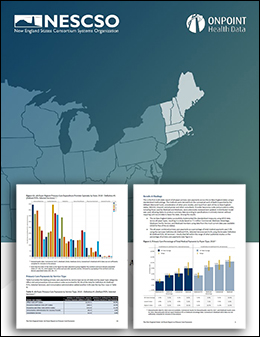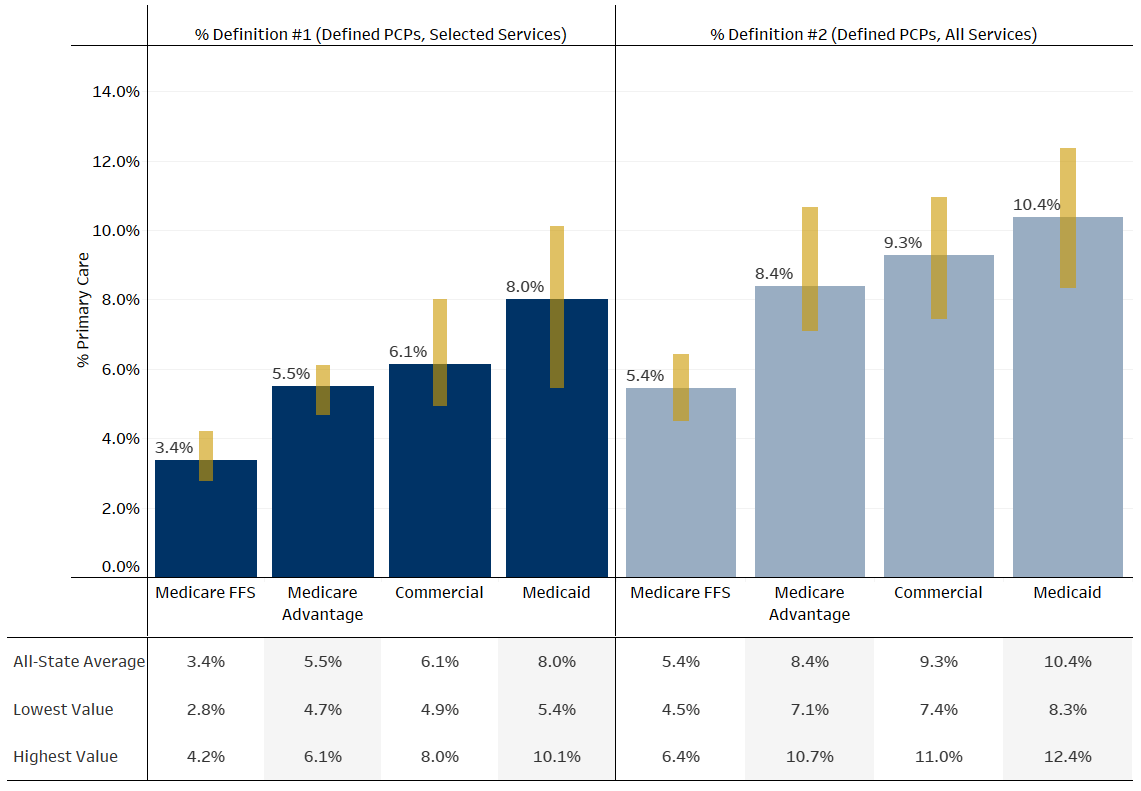NESCSO Engages Onpoint to Develop Analysis of New England States’ Investment in Primary Care

April 2021 – Onpoint recently completed a first-of-its-kind analysis of statewide investments in primary care across all six New England states – Connecticut, Maine, Massachusetts, New Hampshire, Rhode Island, and Vermont. The study, “The New England States’ All-Payer Report on Primary Care Payments,” was sponsored by the New England States Consortium Systems Organization (NESCSO), a coalition governed by the New England states’ Health and Human Services agencies and the University of Massachusetts Medical School, with supplemental funding provided by the Milbank Memorial Fund. The study was made possible through close collaboration across multiple organizations and state teams.
A core objective of the study was to produce a baseline report of all-payer primary care payments and total healthcare costs across the six New England states using state APCD data and the application of a standardized methodology to collect the data. The study’s methods were derived from the conceptual work of Bailit Health (also supported by the Milbank Memorial Fund), consideration of other prior studies on primary care investment, and input from each of the six New England states, NESCSO, Onpoint, and physician and other consultants. A distributed model was used for data collection, allowing states to produce summary data according to standard specifications without requiring unit-record data to leave the state. Since non-claims payments usually are not reported to the states’ APCDs, a data collection template was developed to assist states in gathering and reporting the non-claims payments from payers.
Onpoint worked collaboratively with participants to review prior study methods, update the identification of primary care providers using taxonomy codes, update the list of relevant CPT and HCPCS procedure codes for all-payer reporting, define the specifications and formats for states to submit their summary results, and prepare the final written report.
The study focused primarily on two definitions of primary care payments – (1) a narrower definition that included primary care providers (PCPs) delivering selected primary care services and (2) a broader definition that included PCPs without any restriction on service codes. OB/GYN services were examined separately in order to gain an understanding of how they may influence the payments for primary care.
Among the study’s findings:
- The six New England states successfully implemented the standardized measures using APCD data across all payer types, resulting in a study based on 7.2 million Commercial, Medicare Advantage, Medicare Fee-for-Service, and Medicaid members using data from the most current data year available (2018 for five of the six states).
- The all-payer combined primary care payments as a percentage of total medical payments was 5.5% using the narrower Definition #1 (Defined PCPs, Selected Services) and 8.2% using the broader Definition #2 (Defined PCPs, All Services) – results that fell within the range of other published studies on the percentage of primary care payments (see Figure 1).
Figure 1. Primary Care Percentage of Total Medical Payments by Payer Type, 2018 *

* Massachusetts data for 2018 were not available. Commercial results for Massachusetts were for 2017, and Medicaid results were for 2016. Massachusetts did not report Medicare FFS or Medicare Advantage data. Connecticut did not report Medicaid data.
Based on the findings from this study, NESCSO recommends that states address specific policy and technical issues to improve data collection processes to ensure that the data is useful in evaluating the potential impact of increasing primary care payments as a means to improve quality and reduce costs. Among the report’s recommendations:
- Standardize an approach to collecting data related to non-claims payments
- Standardize an approach that incorporates both the percentage of total cost of care and per member per month (PMPM) payments going to primary care
- Develop a standardized approach to evaluating the association between primary care payments and performance outcomes
- Standardize an approach to incorporating pharmacy expenditures in total healthcare expenditures
- Measure the impacts of COVID-19 on primary care payments, total healthcare expenditures, and other outcome measures
This study, which provides a basis for NESCSO states to work together to advance study methods and gain further insights, also initiates baseline measurements that can be used to guide states’ decision-making and monitor progress related to primary care investments. The study can be accessed at NESCSO’s website.
Explore More
- AI Meets APCD: Using Chatbots to Help Transform Healthcare Transparency
- Staff Spotlight: Monique Yanni (Cote), PMP® - Senior Client Services Manager
- Staff Spotlight: Corey Ramsey, CISSP® - Director of Information Technology
- Using APCDs to Strengthen Funding Applications Under the Rural Health Transformation Program